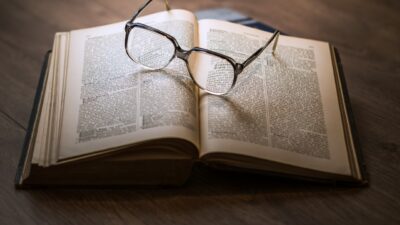Holocaust distortion in the broader context of disinformation and intolerance
Objectives:
- To reflect upon the connection between Holocaust distortion, fake news, hate speech and anti-democratic propaganda
- To develop participants’ understanding of the significant impact that Holocaust distortion can have on the society
Number of participants: 5–30 people
Duration: 75 minutes
Description of the activity:
- The trainer informs the participants that in this activity they will reflect upon the connection between Holocaust distortion and other manifestations of intolerance, and disregard for truth such as fake news, hate speech and anti-democratic propaganda.1
- The participants are invited to a “silent discussion.” Four tables are prepared in the middle of the room, with enough space between them so the participants can move freely. On each table there is a big sheet of paper (two flipchart sheets can be glued together) with one question on each of them:
- How does the normalization of fake news contribute to the spread of Holocaust distortion?
- How do Holocaust distortion and hate speech intertwine?
- In what ways does Holocaust distortion contribute to anti-democratic propaganda?
- How does the spread of Holocaust distortion affect the progress towards sustainable and inclusive societies?
- The participants are invited to walk around and write their reflections for each of the four questions. They can “discuss” in silence by engaging with the texts written by the other participants: they can comment, make links, but they should not erase or write over what is written. If they agree or disagree with a certain remark, they can comment next to it. The participants are not allowed to talk during this activity. They can start at any table they wish and continue around the rest. They should visit each table several times and read what was written in the meantime by the other participants. Each participant can write as many times as they want on each table. Six-seven markers/pencils should be available on each table and 20-30 minutes are allocated for this task, depending on the size and engagement of the group. If this activity is completed online, the silent discussion can be exchanged for a real discussion, by dividing the participants into four groups and asking each group to discuss one of the questions. Alternatively, this activity can be done in an asynchronous way, by posting the questions on a forum/padlet/miro board and asking the participants to write comments between two online meetings that take place on consecutive days or weeks. Then, the debriefing questions can be discussed in a synchronous meeting.
- When the time is up, or when the trainer notices that the participants ran out of ideas, he/she/they invites the participants to take a few minutes to read all comments they have not read so far and then engages the participants in a debriefing discussion based on the following questions:
- How did you feel “discussing” in silence?
- In what ways has this silent discussion helped you understand the connection between Holocaust distortion and other phenomena present in our societies?
- In what ways has this silent discussion helped you understand the impact of Holocaust distortion upon our societies?
- Who do you think is most impacted by Holocaust distortion? In what way?
- In what way are students impacted by Holocaust distortion?
- How does Holocaust distortion erode trust, respect for truth and knowledge?
- What are the highlights of the silent discussion for you?
- Who do you think has a responsibility in countering Holocaust distortion? Why?
- What do you think are your own responsibilities in countering Holocaust distortion?
- The trainer concludes by thanking the participants for their active engagement and by stating that Holocaust distortion has a strong impact on society, both in the specific ways in which it distorts the events of the Holocaust and by contributing to, along with other manifestations, an attack on science and democratic debate:
- Holocaust distortion creates an environment that normalizes or foments hatred, antisemitism and infringement upon human rights.
- The human rights implications of Holocaust distortion are further amplified, as the quantity, availability and speed in which false and misleading information can spread have rapidly increased in the digital era, making young people particularly vulnerable.
- Limitations on access to truthful and accurate information about the Holocaust undermine the ability to form an opinion, understand the world, and make choices free from manipulation and propaganda.
- Therefore, educators have a particular responsibility to contribute to countering it.
1 See UN Special Rapporteur on the promotion and protection of the right to freedom of opinion and expression, “Disinformation and freedom of opinion and expression,” 13 April 2021, UN Doc. A/HRC/47/25.
On this Topic
Lessons for
Topic
Number of participants:
Average Duration of Lesson:

